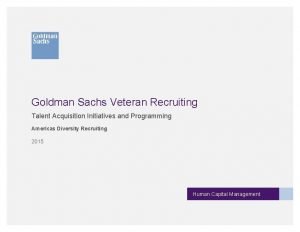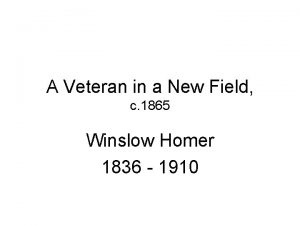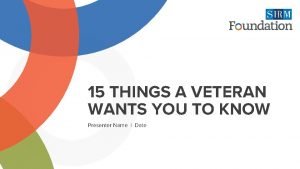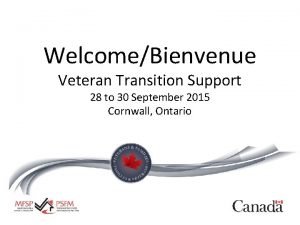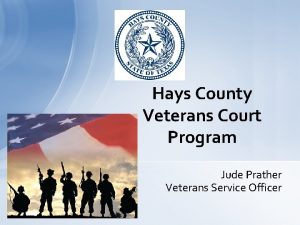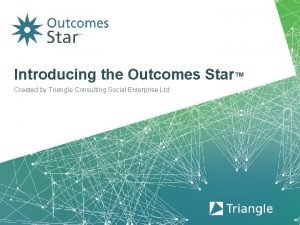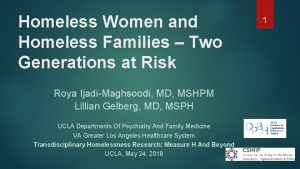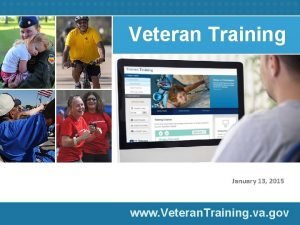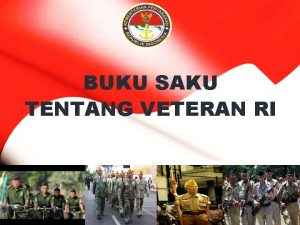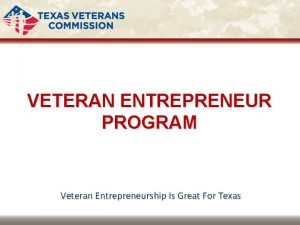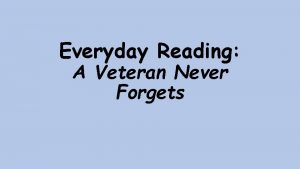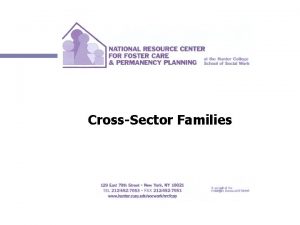DropIn Center for Homeless Veteran Families A Grant










- Slides: 10

Drop-In Center for Homeless Veteran Families: A Grant Proposal Rosalia Marmolejo California State University, Long Beach May 2013

Introduction There are 21. 8 million veterans in the United States (U. S. Census, 2010), and while veterans are only one tenth of the adult population, they make up one third of the homeless population. Many factors contribute to veteran homelessness, however, veterans face unique risks due to their military service (including psychological and cognitive injuries associated with combat and repeated deployments), which can lead to mental health problems, relationship difficulties, and financial hardships (Williamson & Mulhall, 2009 b). The U. S. Department of Housing and Urban Development (2010) found that an estimated 67, 495 veterans were homeless on any given night in 2011, including 4, 425 homeless veteran families. Homeless veteran families have difficulty finding shelter and services, and may be hesitant about pursuing housing assistance. The purpose of this project was to write a grant and identify potential funding sources to develop a program for a multi-service drop-in center for homeless veteran families in Long Beach, California.

Social Work Relevance Homelessness is an issue that is pertinent to the many areas of social work. Social workers are uniquely qualified to work with this population because they play a key role in assisting homeless individuals in both micro and macro levels (Blue-Howells, Mc. Guire, & Nakashima, 2008). In addition to working with the individual mental health problems, unemployment, and substance abuse, social workers also help address policies that might impact the access to affordable housing, as well as advocate for change in policies. This proposed program is relevant to social work because it will attempt to address the different factors that affect homeless veteran families by providing and referring to the appropriate services.

Cross-Cultural Relevance Research shows that minority veterans such as African-Americans and Hispanics have a higher risk of becoming homeless than do White veterans (Perl, 2012). Further, a homeless veteran family likely consists of a minority female who is between the ages of 18 -30 (U. S. Department of Housing and Urban Development, 2010). The different branches of the military should also be considered as an important cultural component, as well as military culture in general. Due to the diversity of this population, it is important to have a program that takes this multiculturalism into consideration. The proposed program will hire culturally diverse staff and provide training to ensure appropriate services are given.

Methods Target population – The target population for this proposed program consists of both male and female homeless veteran families in Long Beach, California. Strategies used to identify and select a funding source – Federal, state, and local databases and internet searches were conducted. In addition, this grant writer searched the foundation directory, located at the Long Beach Non-Profit Partnership. Identify the funding source selected – The Green Foundation is a private organization that serves disadvantaged children and families in Los Angeles County communities. The agency strives to provide hope and support for those not able to help themselves, as well as help the overall community by providing funding for services in impoverished communtities. Available funding is $300, 000 to $500, 000. (Green Foundation, 2012).

Methods Sources used for the needs assessment - The U. S. Department of Housing and Urban Development (www. hud. gov) statistical data was used to show the prevalence of the homelessness problem, changing trends, and demographics in the Long Beach area. Additionally, the U. S. Department of Housing and Urban Development provided resources for federal, state, and local housing assistance. The National Coalition for Homeless Veterans (www. nchv. org) was used to gather information on homelessness among the Veteran population, as well as information on current policies. The Homeless Program staff at the Long Beach VA was also approached to assist with local veteran information and resources. Projected budget range and categories - The total budget for this program is $169, 670 for one year to cover staff and direct program costs.

Grant Proposal Program Summary and Description – Project Support our Troop Families will be a walk-in drop-in center for homeless veteran families, where they are able to access basic needs such as food, emergency shelter, showers, toiletries, clothes, laundry, telephones, mail, as well as more intensive services through case management. This drop-in center will serve as a one-stop shop where veterans will have immediate access to a combination of services, rather than having to go to various locations for different services. Staff will work with homeless veterans and their families on micro, mezzo, and macro levels. Individual case management will be provided to veterans, as well as family members. A support group will be held on a weekly basis and workshops on various topics will be conducted by the Program Director, MSW interns, and community agencies. Referrals will also be made to agencies in the Long Beach community.

Grant Proposal Population Served – This program will serve approximately 100 veteran households in Long Beach, California. Program Objectives – Objective 1: Within 12 months, 50% of participants will receive one-on-one case management services as evidenced by program records. Objective 2: Within 12 months, 50% of participants will have secured affordable housing as evidenced by self-report (i. e. , participating in supportive housing, copy of lease). Objective 3: At program completion, 50% of participants will have obtained a source of income as evidenced by self-report (i. e. , obtaining employment, government assistance, disability). Program Evaluation – Multiple methods will be used to assess the effectiveness of this program. A pre and post-test questionnaire will be used to determine services needed and the services provided to the participants. Qualitative data from participants and staff will be used to measure overall satisfaction with the program and to receive feedback on possible program improvements. Program statistics such as demographics, services needed and received will also be collected. An outside evaluator will be hired to perform the program evaluation.

Lessons Learned & Implications for Social Work Identifying potential funding sources proved to be one of the most challenging aspects of this grant project because funders have very specific criteria for grant awards. Designing a program was not an easy task, and flexibility is important when creating your program. Creating a budget turned out to be a lot easier for this writer than expected. This writer was able to review other grants which were helpful in designing a budget. Grant writing is an important skill that social workers must learn and become familiar with, particularly during times of an economic recession. A social worker who is skilled at grant writing will be able to obtain and sustain funding for the much needed programs in our communities.

References Blue-Howells, J. , Mc. Guire, J. , & Nakashima, J. (2008). Co-location of health care services for homeless veterans: A case study of innovation in program implementation, Social Work in Health Care, 47(3), 219 -231. Green Foundation. (2012). Grant Center. Retrieved from http: //www. ligf. org/# National Coalition for the Homeless. (2009). Why are people homeless? Retrieved from http: //www. nati Perl, L. (2012, February 2). Veterans and Homelessness. Retrieved from http: //www. fas. org/sgp/crs/misc/RL 34024. pdf United States Census. (2010). A snapshot of our nation’s veterans [Date file]. Retrieved from http: //www. census. gov/how/pdf/census_veterans. pdf U. S. Department of Housing and Urban Development. (2010). Veteran Homelessness: A supplemental Report to the 2010 Annual Homeless Assessment Report to Congress. Retrieved from http: //www. hudhre. info/documents/2010 AHAR Veterans. Report. pdf onalhomeless. org/factsheets/why. html U. S. Department of Housing and Urban Development. (2011). The 2011 Point-in-Time Estimates of Homelessness: Supplement to the Annual Homeless Assessment Report [Data file]. Retrieved from http: //www. hudhre. info /documents/PIT-HIC_ Supplemental. AHARReport. pdf Williamson, V. , & Mulhall, E. (2009 b). Invisible wounds: Psychological and neurological injuries confront a new generation of veterans. Retrieved from http: //iava. org/reports
 Little families
Little families Goldman sachs veterans integration program
Goldman sachs veterans integration program Winslow homer veteran in a new field
Winslow homer veteran in a new field 15 things every veteran wants you to know
15 things every veteran wants you to know Veteran market segmentation
Veteran market segmentation Veteran transition academy
Veteran transition academy Schedule a hiring authority 5 cfr 213,3102(u)
Schedule a hiring authority 5 cfr 213,3102(u) Hays county veteran services
Hays county veteran services Indiana veteran license plate
Indiana veteran license plate Homelessness outcome star
Homelessness outcome star Elizabeth murray harvard
Elizabeth murray harvard

